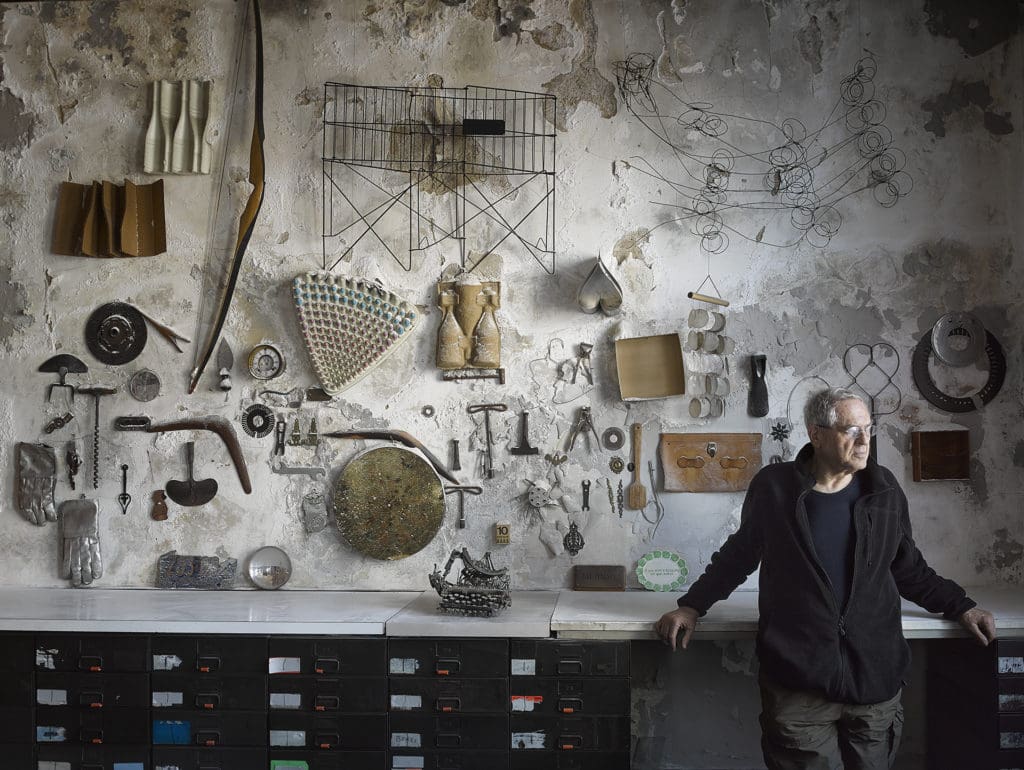
On March 17, 1966, photographer Jay Maisel bought the Germania Bank building in New York City’s East Village. He then spent nearly five decades filling the six-story building with things most would consider junk: old film canisters, batteries, a glass bust filled with pills, etc. “I collected like I was gonna live here forever,” he tells director Stephen Wilkes in the documentary Jay Myself. However, unable to keep up with the $300,000 annual cost of maintaining the building, Maisel decided to sell it in 2014. Wilkes, who began an internship with Maisel in 1979, is devastated at the news and the primary function of his fun, fascinating documentary is to capture Maisel’s longtime home/studio one last time before it disappears.
Seeing the piles of items others literally consider trash and the translated comment from a mover joking that Maisel keeps the trash and throws out anything of value, it’s easy to suggest the artist has a hoarding issue. However, outside of some comments from Maisel about loving to take things apart and some general conversations about depression, Wilkes leaves both in-depth backstory and psychological analysis relatively untouched. Rather than pass any judgement on Maisel’s collecting, Wilkes presents it as an aspect of Maisel’s personality essential to his work.
“I think there’s a delight in the perception and the enjoyment of objects,” Maisel says early on and Wilkes does his best to convey that feeling. When Maisel says he has a room filled with “just circles,” Wilkes flashes to an image of that room, filled with gears and wheels and all manner of round things. When Maisel says that professor Josef Alber taught him about color at Yale, we see photos with bright, prominent colors that emphasize Maisel’s assertion that color is “extremely seductive” and “chameleon-like” based on light conditions.
Most striking of all, though, is a scene late in the film during the final days of the move. As Amanda, Maisel’s daughter explains, she spent much of her childhood being told not to touch a collection of ceramic hands placed on a mattress. As Maisel explains in archival footage, his intent was to capture the passage of time in a single photograph and watching him finally shoot the result of that experiment decades later–just days before the move–it’s impossible to deny that even if Maisel’s collecting speaks to something unhealthy, it’s also true that he was also able see the beautiful in the mundane.
However, lovely as that scene is, watching it inevitably makes the viewer wish for more detail on both Maisel’s artistic and commercial careers. Though Wilkes convincingly argues for Maisel’s skill for an audience not already aware, he leaves the milestones and details of Maisel’s career largely untouched. Though we see archival footage of him shooting a Sports Illustrated Swimsuit issue, the thinking behind his decision to do that work remains tantalizingly unexplored. Rather, the most we hear about any one job are the RCA spreads for which Maisel received the $25,000 that allowed him to put a down payment on the bank building.
Still, while Jay Myself isn’t quite the career retrospective some viewers may want, it’s also important to remember that that was never Wilkes’s goal anyway. As he says in the opening voice overs, the reason he starts making the film is because he wants to capture the building that represents such a formative time in his career before it’s gone. And while that loss is personal for Wilkes, the other artists who know Maisel and Jay himself, Wilkes paints such a potent picture of this New York City oddity that it’s hard not to share that nostalgia by the end.
As Amanda puts it in the final days before the move, the building is a testament to a New York City that’s all but disappeared. The Germania Building as her father kept it is “weird” and “doesn’t make sense.” It’s a relic from an un-gentrified New York, grimy and covered in graffiti, where a fledgling artist could buy a historic bank building and fill it with his imagination. Sure, it’s eccentric and undeniably extravagant when the surrounding streets are filled with poverty, but that idea is precisely what makes New York such a romantic ideal. Losing the building is nothing short of the embodiment of the city being slowly wiped clean of its character.

